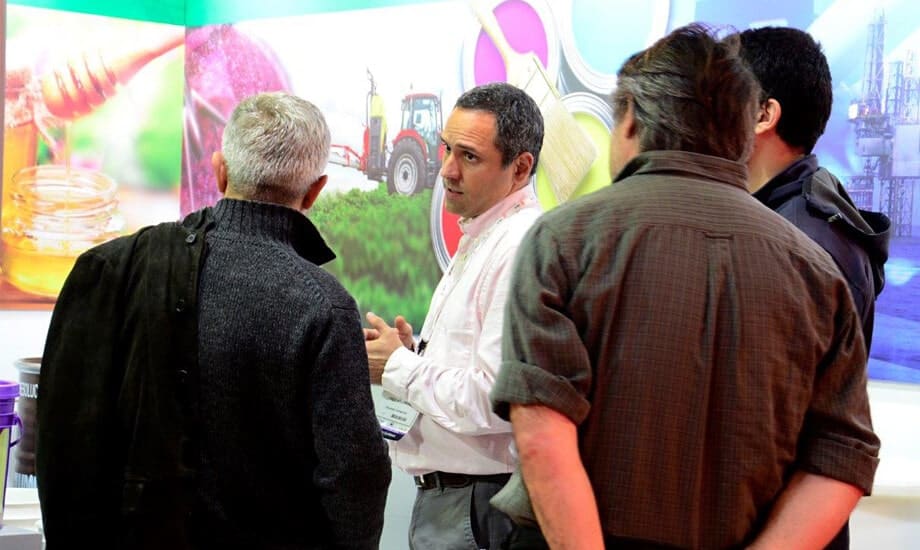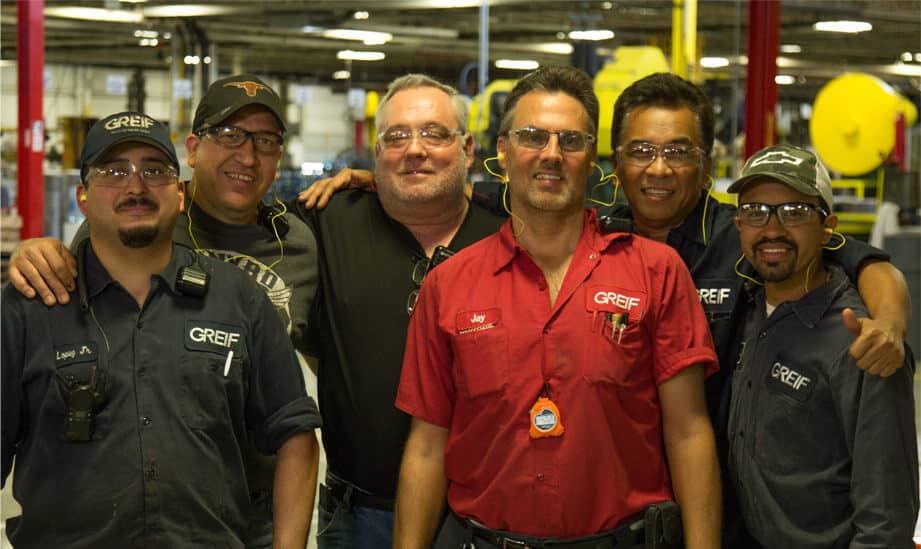Why Supply Chain Management Matters
Governance
Greif sources direct materials such as resins, paint and steel and indirect materials such as consumables, services and transportation. Greif’s Global Sourcing and Supply Chain Team (GSSC) tracks monthly improvements in material costs, working capital, deal terms and inventory as part of the Greif Business System (GBS). We outline our expectations for our suppliers in our Supplier Code of Conduct, which we updated in 2021. We evaluate each of our top 20 suppliers on a scorecard that considers quality, delivery, cost, value-added services, environmental impact and technical support. Sustainability criteria, such as material reduction, use of lower environmental impact materials and supplier sustainability initiatives account for five percent of the supplier scorecard.
Greif complies with applicable laws to manage potential human rights violations in our supply chain. Due to the fact that some Greif products contain tin, we are committed to understanding the 3TG metals in our supply chain. To assess conflict risk throughout our supply chain, we validate our Conflict Minerals Policy and publish our Conflict Minerals Report annually. In accordance with the California Transparency in Supply Chains Act of 2010, Greif takes measures to prevent and eliminate forced labor in our direct supply chain, as outlined in our Supplier Code of Conduct and Transparency in Supply Chain Disclosure. We continuously monitor regulations to ensure compliance and alignment with best practices.
All new suppliers are given access to our Supplier Code of Conduct via Greif.com and expected to adhere to the principles within. Globally, our Supplier Code of Conduct is part of every purchase order and agreement that has to be signed by our suppliers. In 2020, we began sending our Supplier Code of Conduct with legacy Caraustar purchase orders. This began elevating the importance of the Supplier Code of Conduct and environmental, social and governance topics with our suppliers and during our buying decision process.
In 2021, we updated our Supplier Code of Conduct to expand its scope and strengthen its language. In the new code, we better outline our expectations and address environmental and social risks within our supply chain based on the key industries that we serve. We issued an updated Supplier Code of Conduct as a formal policy and began stronger enforcement among our suppliers, including integration into supplier audits and in all negotiated Agreements and Purchase Orders. We require that all suppliers agree to the new Supplier Code of Conduct before completing a purchase order. In 2021, we revised our internal Purchasing Policy that provides guidelines for procurement to our colleagues. The policy includes considerations for environmental and social procurement criteria, including green materials, waste and supplier diversity. We also published updated Temporary Labor Policies in the United States and Canada. The Temporary Labor Policy formalizes additional requirements for temporary labor agency providers and maintains compliance with all regulatory requirements.
During our Enterprise Risk Management process, we recognize supply chain as a critical risk to carefully manage as it may impact our business continuity or ability to deliver on customer commitments. We must be able to supply our colleagues and facilities with what they need to deliver customer service excellence and meet our standards of product quality. During 2020, maintaining a continuous supply chain was critically important to support business continuity through the COVID-19 pandemic. We leveraged our existing procedures, controls and processes to ensure our facilities had all the supplies they needed including personal protective equipment. Through a collaborative approach with suppliers, we minimized shortages by utilizing back up and new suppliers when needed.
Since the onset of the COVID-19 pandemic, we have confronted several obstacles, including supply constraints and labor challenges. We focused on consistent communication with suppliers and customers to navigate these challenges while continuing to meet our customer’s needs and expectations. We worked with our suppliers and backup suppliers to meet customer demand. We conducted one-on-one meetings and webinars to keep our customers informed of the obstacles we faced and our plans to overcome them. We attribute our success in navigating COVID-19 related challenges to our consistent communication and transparency to both suppliers and customers. Please visit the Customer Service Excellence section of our report to learn more about our approach to customer service.
Supply chain sustainability objectives are supported by our Sustainable Procurement Team, which evaluates opportunities to minimize material use and finds more sustainable raw material alternatives. The team, made up of colleagues from each region, evaluates opportunities across the globe and works to share best practices in sustainable sourcing with the Global Procurement Team. In 2018, we began replacing combustible gasoline and LPG powered forklifts with electricity-powered forklifts. The transition both supported Greif’s Renewable Forklift Policy and resulted in significant emissions savings. Through 2021, we converted 85 percent of our forklifts in EMEA to electricity power and realized a cost savings of $365,000 in 2021.
We also made changes to impact energy and emissions use among our trucks and colleague vehicle fleet. We transitioned 99 percent of our North American fleet to solar-powered GPS units through 2021. In EMEA, we set stringent emission guidelines for approved colleague vehicles to promote more energy efficient and, where feasible, electric vehicles. We transitioned 60 percent of our vehicle fleet in EMEA through this program and realized $261,000 in cost savings since the program launched.
In 2020, we began replacing old and small copiers across our global footprint with more functional units. The new copiers include software that limits printing for users and will reduce paper and toner use globally. At our Delaware headquarters, the new copiers led to a nearly 3 million reduction in prints over four years. During 2021 in North America, we replaced old and small copiers with the new copiers at over 60 plants. Collectively, we continue to track procurement projects that have potential to provide positive sustainability impacts through GBS. In North America, we saved nearly $400,000 in 2021 on energy costs through three projects to reduce our energy demand.
Greif works to identify and implement chemical substitutions in our products and operations to remove and reduce hazardous waste, including volatile organic compounds (VOCs). Since 2015, we have focused on reducing steel coil material volume and potentially hazardous paint within our operations. We now use safer alternatives in many of our products, including our Tri-Sure Vreeland linings and our water-based acrylic paints. In fact, all our North America facilities, except in Auburndale, Florida, are using water-based paints. In Europe, five countries use water-based paints alongside solvent based paints. Our Asia Pacific (APAC) facilities are also transitioning to water-based paints, including our Zhuhai facility, where 75 percent of their paint usage was water-based in 2021. The steps we take to reduce hazardous waste align with our Environmental Health and Safety Policy.
We continue to integrate environmental and social criteria into our supplier audits. To ensure continuous supplier improvement in areas such as colleague health and safety, we integrated language on conformance to standards and ISO certification development into our supplier audits. We benchmarked industry best practices to improve our supplier scorecards, Supplier Code of Conduct and rating procedures. We created legal training on anti-trust policies and products, available to all colleagues through Greif University. We are utilizing EcoVadis assessments to analyze the sustainability performance of our suppliers. We began requesting that our largest suppliers complete EcoVadis assessments in 2020. Thus far, suppliers accounting for 20 percent of our supplier spend have submitted EcoVadis responses. This year we set a new target to assess 35 percent of our supplier spend by the end of 2022. As part of this program, we trained our buyers on EcoVadis to understand the assessment, recognize the factors EcoVadis is rating and best utilize information from the assessments.
In 2020, we developed strategic roadmaps detailing our supply chain strategy through 2025. As part of this roadmap, we have identified sustainability project opportunities related to our major procurement work streams. Based on the outcomes of our Voice of the Customer project, we are also working to involve our GSSC team more in the execution of customer service. Involving our GSSC team allows us to take a more proactive approach, improve communication with facilities and customers and realize additional cost savings. In 2022, we plan to expand our roadmap by setting targets and plan initiatives that extend through 2030.
Goals & Progress
In 2017, we set 2025 goals to:
- Using a fiscal year 2017 baseline, reduce raw materials/logistical costs used to produce current product offering by one percent.
- Move from non-green (oil-based, more energy intensive) to green material sourcing if it is economically feasible and doing so provides high quality products to our customers.
We reduced our raw materials by 0.7 percent by the end of 2021, and we are on track to meet our goal of one percent by 2025. To continue progressing our 2025 goals, we incorporate our goals into our RFQ process when soliciting potential suppliers. Our sourcing managers incorporate topics such as carbon content, recyclability and packaging improvement into conversations with many of our suppliers to identify opportunities to advance our goals. We have made green material substitutions to increase the use of post-consumer regrind plastic in our products. We increased our efficiency with corrugated cardboard boxes and other packaging materials to increase reusability, while optimizing logistical routes, to reduce shipping expenditures. In some EMEA facilities, we have introduced a more biodegradable oil to clean our paint lines. The move from non-green products and materials, such as oil-based products, has prompted us to engage in green-material sourcing from our suppliers. We have already begun to move away from solvent based paints to water-based paints and liners for drums. We supplement this collaborative work by internal changes, such as a transition to LED lights. These initiatives are all a part of a larger training initiative with the supply chain team to think-of and develop new projects and integrate sustainability into the buyer’s performance appraisals for 13 of our buyers, including buyers for steel, resin and logistics.
Sustainable Forest Management
Greif Paperboard mills are Sustainable Forestry Initiatives (SFI®) Certified, Forest Stewardship Council (FSC®) Certified and Program for the Endorsement of Forest Certification (PEFC®) Chain of Custody Certified. These certification systems provide third-party certification to track and communicate the amount of product that comes from sustainably managed land.

EcoVadis
In 2021, Greif earned Gold Recognition level from EcoVadis for superior Corporate Social Responsibility performance. This score places Greif in the top four percent of all suppliers assessed by EcoVadis.

Together for Sustainability
Together for Sustainability
Since 2014, Greif has worked with Together For Sustainability (TfS), to help build an industry-wide sustainability standard for suppliers to chemical manufacturers. On behalf of its more than 20 chemical manufacturer members, TfS audits supply chain partners on more than 30 management, environment, health and safety, labor and human rights and governance criteria. TfS distributes results to their members to support purchasing decisions, replacing the need for company-specific audits and holding suppliers to a consistent standard for the industry. Ten Greif facilities have been audited since 2014, achieving an average score of 94.3 percent, indicating no major concerns at our facilities. In 2021, TfS conducted an audit of our Mendig, Germany facility.
TfS Audit Performance
- RIPS Naperville, Illinois: 100%
- RIPS Mendig, Germany: 98%
- RIPS Cologne, Germany: 98%
- RIPS Lockport, Illinois: 98%
- FPS Sultanbeyli, Turkey: 98%
- RIPS Europoort, Netherlands: 97%
- RIPS Attendorn, Germany: 96%
- RIPS Usti, Czech Republic: 95%
- RIPS Campana, Argentina: 83%
- RIPS Shanghai, China: 80%

SUSTAINABILITY HIGHLIGHTS
$400,000
Saved in 2021
In North America, we saved nearly $400,000 in 2021 on energy costs through three projects to reduce our energy demand.
60%
Of EMEA Vehicle Fleet Transitioned to Electric and Hybrid Vehicles
Through stringent emission guidelines for approved colleague vehicles leading to $261,000 in cost savings.







